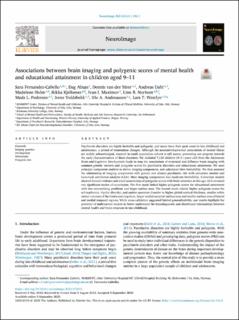| dc.contributor.author | Fernandez-Cabello, Sara | |
| dc.contributor.author | Alnæs, Dag | |
| dc.contributor.author | van der Meer, Dennis | |
| dc.contributor.author | Dahl, Andreas | |
| dc.contributor.author | Holm, Madelene Christin | |
| dc.contributor.author | Kjelkenes, Rikka | |
| dc.contributor.author | Maximov, Ivan | |
| dc.contributor.author | Norbom, Linn Christin Bonaventure | |
| dc.contributor.author | Pedersen, Mads Lund | |
| dc.contributor.author | Voldsbekk, Irene | |
| dc.contributor.author | Andreassen, Ole | |
| dc.contributor.author | Westlye, Lars Tjelta | |
| dc.date.accessioned | 2023-03-02T12:15:01Z | |
| dc.date.available | 2023-03-02T12:15:01Z | |
| dc.date.created | 2022-10-25T14:47:09Z | |
| dc.date.issued | 2022 | |
| dc.identifier.citation | Fernandez-Cabello, S., Alnæs, D., van der Meer, D., Dahl, A., Holm, M., Kjelkenes, R., Maximov, I. I., Norbom, L. B., Pedersen, M. L., Voldsbekk, I., Andreassen, O. A., & Westlye, L. T. (2022). Associations between brain imaging and polygenic scores of mental health and educational attainment in children aged 9–11. NeuroImage, 263:119611. | en_US |
| dc.identifier.issn | 1053-8119 | |
| dc.identifier.uri | https://hdl.handle.net/11250/3055354 | |
| dc.description.abstract | Psychiatric disorders are highly heritable and polygenic, and many have their peak onset in late childhood and adolescence, a period of tremendous changes. Although the neurodevelopmental antecedents of mental illness are widely acknowledged, research in youth population cohorts is still scarce, preventing our progress towards the early characterization of these disorders. We included 7,124 children (9–11 years old) from the Adolescent Brain and Cognitive Development Study to map the associations of structural and diffusion brain imaging with common genetic variants and polygenic scores for psychiatric disorders and educational attainment. We used principal component analysis to derive imaging components, and calculated their heritability. We then assessed the relationship of imaging components with genetic and clinical psychiatric risk with univariate models and Canonical correlation analysis (CCA). Most imaging components had moderate heritability. Univariate models showed limited evidence and small associations of polygenic scores with brain structure at this age. CCA revealed two significant modes of covariation. The first mode linked higher polygenic scores for educational attainment with less externalizing problems and larger surface area. The second mode related higher polygenic scores for schizophrenia, bipolar disorder, and autism spectrum disorder to higher global cortical thickness, smaller white matter volumes of the fornix and cingulum, larger medial occipital surface area and smaller surface area of lateral and medial temporal regions. While cross-validation suggested limited generalizability, our results highlight the potential of multivariate models to better understand the transdiagnostic and distributed relationships between mental health and brain structure in late childhood. | en_US |
| dc.language.iso | eng | en_US |
| dc.publisher | Elsevier | en_US |
| dc.rights | Navngivelse 4.0 Internasjonal | * |
| dc.rights.uri | http://creativecommons.org/licenses/by/4.0/deed.no | * |
| dc.title | Associations between brain imaging and polygenic scores of mental health and educational attainment in children aged 9–11 | en_US |
| dc.type | Peer reviewed | en_US |
| dc.type | Journal article | en_US |
| dc.description.version | publishedVersion | en_US |
| dc.rights.holder | © 2022 The Authors. | en_US |
| dc.source.volume | 263 | en_US |
| dc.source.journal | NeuroImage | en_US |
| dc.identifier.doi | 10.1016/j.neuroimage.2022.119611 | |
| dc.identifier.cristin | 2064903 | |
| dc.source.articlenumber | 119611 | en_US |
| cristin.ispublished | true | |
| cristin.fulltext | original | |
| cristin.qualitycode | 2 | |

